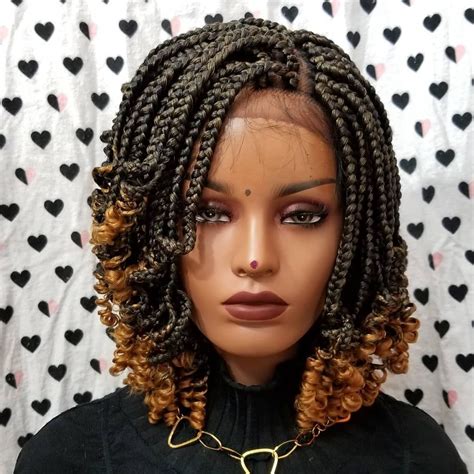Introduction
Braided wigs have surged in popularity among black women seeking protective and versatile hair options. With their intricate designs and endless styling possibilities, these wigs offer a stylish and convenient way to experiment with different looks while preserving natural hair health.

Types of Braided Wigs
1. Box Braids
Box braids are characterized by their square-shaped sections that create a voluminous and textured appearance. They come in varying lengths and thicknesses, allowing for customization based on personal style.
2. Cornrows
Cornrows are thin, raised braids that form geometric patterns on the scalp. They can be worn up or down, providing both edgy and sleek options.
3. Goddess Braids
Goddess braids feature a voluminous, loose style that resembles traditional African hairstyles. They create an elegant and regal aesthetic that is perfect for special occasions.
4. Senegalese Twists
Senegalese twists are similar to box braids but are made using two strands of hair instead of three. The result is a more natural and textured look that can be worn for extended periods.
5. French Braids
French braids are versatile and intricate braids that start at the crown and are gradually added to as they reach the ends. They provide a chic and feminine touch to any hairstyle.
6. Dutch Braids
Dutch braids are similar to French braids but with an “underhanded” technique that creates a raised and voluminous effect. They are often used to frame the face or as a centerpiece of an updo.
7. Tree Braids
Tree braids resemble small, individually braided ponytails that are attached to the head. They provide a unique and playful touch to any hairstyle and are popular among younger women.
8. Micro Braids
Micro braids are tiny and delicate braids that are installed close to the scalp. They offer long-lasting protection and are known for their versatility and ability to create intricate designs.
9. Crochet Braids
Crochet braids are installed using a crochet hook to weave extensions into the natural hair. They mimic the appearance of natural braids and offer a wide range of styling options.
10. Dreadlock Wigs
Dreadlock wigs feature tightly coiled sections of hair that create a unique and edgy look. They are available in various lengths and styles, providing a bohemian and adventurous touch to any outfit.
11. Wig Caps
Wig caps are a must-have accessory for any braided wig. They help to secure the wig in place, prevent slipping, and absorb moisture. They come in various colors and materials to suit different skin tones and hair textures.
12. Wig Accessories
Various accessories can enhance the look of braided wigs, such as hair jewelry, scarves, and headbands. These accessories can add a touch of flair and personality to any hairstyle.
Benefits of Braided Wigs
- Protective: Braided wigs provide a protective barrier for natural hair, allowing it to grow and recover from damage caused by heat, chemical treatments, or styling practices.
- Versatile: Braided wigs offer endless styling possibilities, allowing women to change their look without altering their natural hair.
- Low-Maintenance: Braided wigs require minimal maintenance compared to natural hair, making them ideal for busy or active lifestyles.
- Time-Saving: Installing a braided wig is a time-saving alternative to braiding natural hair, which can be a lengthy and intricate process.
- Customizable: Braided wigs can be customized to suit individual preferences, with options for different braid patterns, lengths, colors, and textures.
Choosing the Right Braided Wig
Consider the following factors when choosing a braided wig:
- Face Shape: Choose a wig that complements your face shape. Oval and round faces suit most braid styles, while square and heart-shaped faces benefit from softer, looser braids.
- Hair Texture: Match the texture of the wig to your natural hair for a natural and seamless blend.
- Length: Consider your lifestyle and personal style when choosing a wig length. Short wigs are versatile and low-maintenance, while long wigs offer more styling options.
- Color: Experiment with different colors to complement your skin tone and create a unique look.
- Density: The density of the wig refers to the number of braids per square inch. Choose a density that suits your desired level of volume and fullness.
Installing a Braided Wig
- Prepare your hair: Braid or cornrow your natural hair into small sections to create a smooth base.
- Apply a wig cap: Cover your natural hair with a wig cap to protect it and prevent slipping.
- Adjust the wig: Place the wig on your head and adjust the straps and hooks to ensure a snug and comfortable fit.
- Secure the edges: Use bobby pins or wig adhesive to secure the edges of the wig and blend it with your natural hair if necessary.
Caring for Braided Wigs
- Brush gently: Use a wide-toothed comb or detangling brush to remove tangles gently.
- Wash infrequently: Wash your wig every 2-4 weeks to prevent product buildup and damage.
- Use warm water: Use lukewarm water to wash your wig, as hot water can cause tangling.
- Condition regularly: Apply a wig conditioner after washing to keep the braids soft and manageable.
- Air dry: Allow your wig to air dry completely before storing or wearing it again.
Conclusion
Braided wigs offer an endless array of styling possibilities, protective benefits, and low-maintenance convenience. By choosing the right wig for your individual needs and preferences, you can unlock a transformative hairstyle journey that empowers you to express your unique style.
